Break-in
The more you treat the engine with care at the beginning of its use, the more satisfied you will be with its work later. For the first 1500 km, avoid high load (driving at wide open throttle) and high engine speed (no more than 2/3 of the maximum speed in the selected gear).
Change gears in time!
When pressing the accelerator pedal, it is desirable not to overcome the point of resistance ("kick-down").
Do not downshift with the selector lever to brake.
Select shift ranges 3, 2 or 1 only at low speeds (on mountain passes).
After the first 1500 km, the speed and the number of revolutions can be gradually increased to the limit values.
Help system - TeleAid
(Telematic Alarm Identification on Demand - used in some European countries).
Basic functions
Call for help - the call for help system allows you to send a call for help signal to the rescue service control center in certain European countries (see the description below).
Telediagnosis - will help you, for example, in case of technical problems on the car or in the event of an accident. When this service is called up, vehicle parameters regarding location and identity are transmitted. You can request this service from your TeleAid fixed telephone (separate “Telephone User Guide”).
"MB"-Info - will help you with all questions related to the car, such as, for example, accessories. You can request this service from your landline phone with TeleAid system.
The call for help system allows the transmission of a call for help signal to one of the ambulance control centers within certain European countries.
The call for help is transmitted automatically after an accident. If a dangerous situation arises, you can activate the help system manually. In this case, all information necessary for assessing an accident is transmitted, such as data on the location of the vehicle (determined by the GPS satellite navigation system, as well as ABS path sensors) and regarding the severity of the accident.
In a short time after the call for help system is triggered, voice communication is automatically established between the ambulance control center and the passengers of the injured car. If any of the passengers are able to speak, they can give more detailed information about the consequences of the accident to the staff of the ambulance control room. The phone is in speakerphone mode.
The system for calling for help is provided if:
· there is a valid contract with the services offering the corresponding services (telephone service and the service for receiving call signals for help).
· have a valid personal identification code (PIN), phone card (SIM), and permission to use the TeleAid system.
· access to an appropriate radiotelephone network (access is possible only within Germany on the basis of networks D1 and D2), which provides the transmission of short messages via the SMS service (Short Message Service),
· the availability of the call for help system.
When the ignition key is turned to position 1 or 2, the assistance call system is operational.
The control LED on the call system button lights up for approximately 5 seconds.
When the key is turned to position 0 in the ignition switch or when the key is removed, the help call system is no longer operational.
Call for help
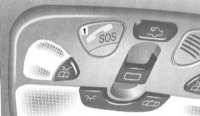 |
|
Manually: Lightly press the cover -1- - the cover opens.
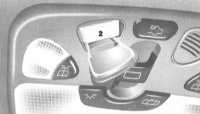 |
|
Lightly press the help call button -2-.
The control LED on the help call button -2- flashes.
The receipt of a call signal for help for further transmission to the ambulance control room is confirmed by a message through the loudspeaker installation. Wait for voice communication with the ambulance control room.
After calling for help, close the cover -1-.
Automatically:
· when the airbag is deployed;
in case of a strong impact on the car from behind;
when the vehicle rolls over.
The control LED on the help call button -2- flashes.
The receipt of a call signal for help for further transmission to the ambulance control room is confirmed by a message through the loudspeaker installation. Wait for voice communication with the rescue service control center.
|
The universal display first shows "EMERGENCY CALL" "CALL IN PROGRESS", and after the connection is established, the indication "EMERGENCY CALL" "CALL ACTIVE". |
The control LED flashes until the call for help ends.
After the call for help is transmitted, the phone switches to the speakerphone mode after a few seconds until the end of the exchange of information between the rescue service control center and the passenger of the car.
During this time, it is not possible to conduct other telephone conversations.
|
If the voltage is too low (for example, when the battery is discharged), the call for help cannot be transmitted via the help call system. |
After transmission of the call for help :
If the control LED on the button of the call for help is permanently lit and no voice communication has been established before, the transmission of the call for help has failed (eg no radiotelephone network). "EMERGENCY CALL" "CALL FAILED" appears on the universal display.
In this case, rescue activities must be organized on their own.
Emergency battery
The TeleAid system has an additional emergency battery in case the vehicle's battery cannot be used, for example, due to low voltage or a dead battery.
|
To avoid discharging the emergency battery when the vehicle battery is disconnected, the phone must be put into maintenance mode ("Telephone User's Guide"). |
Ignition switch
Risk of accident!
Remove the key from the ignition switch even when leaving the vehicle for a short time.
The electric seat and steering wheel adjustment is also possible with one door open. Therefore, do not leave children in the car unattended.
Manual transmission models: Do not remove the key until the vehicle has stopped. With the key removed, the car is uncontrollable.
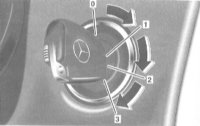 |
|
0 - When the key is removed, the steering is locked.
Models with automatic transmission The
key can be removed only if the AT selector lever is in the "P" position and the service brake pedal is not pressed.
1 - Steering is released.
Most electrical consumers can be switched on.
For more detailed information, please refer to separate datasheets.
2 - Driving
Gasoline models
Driving
position. All electrical consumers can be switched on.
Models with diesel engine
Preheat position and movement. All electrical consumers can be switched on.
Models with automatic transmission
The AT selector lever is released.
If the AT selector lever is in the “P” position, to move it, additionally depress the brake pedal.
Sequentronic automated transmission
Gear shifting is possible.
3 - Start
(Start and stop the gasoline engine - see below).
(Diesel engine start and stop - see below).
Locking the steering lock
After removing the key, turn the steering wheel until it locks.
Unlocking the steering lock
Insert the key into the ignition switch - the steering lock is unlocked while slightly turning the steering wheel.
|
Do not stick the infrared window on the tip of the key and do not allow it to become dirty, otherwise the operation of the ignition switch cannot be guaranteed. |
Starting and Stopping the Gasoline Engine
Before starting Apply the
parking brake.
Move the manual transmission shift lever to the neutral position.
Move the shift lever of the Sequentronic automated transmission to the "N" position.
Move the automatic transmission shift lever to the "P" or "N" position.
Starting
Models with manual transmission Turn
the key in the ignition switch to position 3 and release as soon as the engine starts.
Do not press the accelerator pedal.
Models with automatic transmission
Turn the key in the ignition switch to position 3 and release. The starting process is carried out automatically until the engine starts or for a certain period of time - the impulse start function.
Do not press the accelerator pedal.
Restarting
Before restarting, turn the ignition key back to position 0 and repeat the starting process, keeping the key in position 3 until the engine starts.
If the engine does not start after a long process, contact a Mercedes-Benz workshop.
|
Excessive starting attempts will drain the battery. Emergency start by towing models with AT is not possible. |
Stopping the vehicle engine
After the vehicle has come to a complete stop, turn the ignition key to position 0. Apply the parking brake.
Models with automatic transmission The
key can be removed only in position 0 of the ignition key if the AT selector lever is in the "P" position and the service brake pedal is not pressed.
Starting and Stopping the Diesel Engine Before
starting Apply the
parking brake.
Move the manual transmission shift lever to the neutral position.
Move the shift lever of the Sequentronic automated transmission to the "N" position.
Move the automatic transmission selector lever to the "P" or "N" position.
launch
Preheat
Turn the key in the ignition switch to position 2. The preheat indicator lamp lights up.
Manual transmission models
If the preheat warning light goes out, turn the key in the ignition switch to position 3 and release as soon as the engine starts.
Do not press the accelerator pedal.
Models with automatic transmission
When the preheat indicator lamp goes out, turn the key in the ignition switch to position 3 and release. The starting process is carried out automatically until the engine starts or for a certain period of time - the impulse start function.
Do not press the accelerator pedal.
Starting a warm engine: The engine can be started without preheating.
Repeat launch
Before restarting, turn the key in the ignition switch back to position 0 and repeat the starting process, keeping the key in position 3 until the engine starts.
If the engine does not start after a long starting process, contact a Mercedes-Benz dealer.
|
If the preheat control lamp does not light up, then the preheating system is faulty, contact a Mercedes-Benz service station immediately to eliminate the malfunction. |
Emergency start of the engine by towing is possible only for models with manual transmission (Introduction).
Emergency stop of the engine
If the engine cannot be switched off with the key, it can be switched off by removing the two fuses.
To do this, remove the two fuses, marked in the fuse overview with the inscription "ENGINE EMERGENCY STOP", using a fuse remover.
An overview of the fuses and spare fuses can be found in the fuse box in the passenger compartment.
The fuse remover is located in the additional trunk fuse box.
Starting off and shifting gears
Warm up the engine quickly after starting off. Only then can the load be brought to full power.
Starting off on slippery ground: avoid prolonged turning of one of the drive wheels. This could damage the transmission.
Manual gearbox (RKPP)
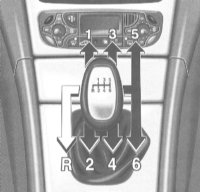 |
|
Do not exceed the maximum speeds for individual gears.
Switching to reverse gear is allowed only after the vehicle has stopped. To do this, lift the gearshift lever.
There is a risk of skidding!
Do not shift into a lower gear if the maximum speed in that gear is exceeded. Drive wheels can be blocked.
On a slippery road, do not downshift to slow down.
|
Shifting to a lower gear at too high speed (for braking purposes) can lead to exceeding the maximum permissible engine speed and thus damage the engine. |
Parking
Depress the parking brake pedal.
Engage 1st gear or reverse gear.
On steep inclines or descents, turn the front wheels toward the curb.
Automated gearbox (Sequentronic)
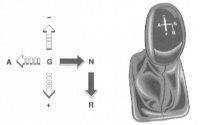 |
|
The gearshift diagram is shown on the backstage of the gearbox.
"G" Drive position/home position ("G")
"-" Downshift
"+" Upshift
"N" Neutral position
"R" Reverse gear
"A" Automatic
Sequentronic automatic transmission provides manual and automatic gearshift modes .
In manual mode, gear selection is made by lightly pressing the gearbox backstage in the “+” or “-” direction.
In automatic mode, gear shifting is performed automatically.
Unlike a manual transmission, in the manual mode of a Sequentronic automatic transmission, the shift process is performed only when the shift conditions are met (for example, maximum speed, depressing the brake before shifting to the “R” position).
There is a risk of injury!
When carrying out work on the car with the engine running, apply the parking brake, and shift the gearbox rocker to the “N” position in order to prevent the car from starting.
Gearbox
positions “G” Driving position/home position
All six forward gears are used.
"+" Upshift (Manual Mode)
Upshifts in manual Sequentronic mode.
By lightly pressing the gearshift lever in the “+” direction, the gear shifts to the next higher gear.
"-" Downshift (manual mode)
By lightly pressing the gear shift in the “-” direction, the next lower gear is switched.
"N" Neutral position
The engine can only be started if the gearshift rocker is in the "N" position.
"R" Reverse gear
Engagement of reverse gear is possible only when the car is stopped and the brake pedal is depressed.
"A" Automatic mode
All gears are used to move forward.
The optimum gear is automatically switched on.
Indication on the universal display
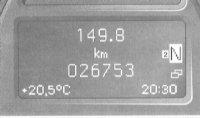 |
|
2 - Gearbox position indication Gearshift
conditions The gearshift
process can be carried out under the following conditions.
With the engine off and the key in the ignition switch in position 2:
To park the car, it is possible to shift gears from position "N" to driving position "G" or to reverse gear "R" without additional preliminary depressing of the brake pedal.
Gear shifting to the neutral position "N" is possible only when the brake pedal is depressed.
|
Gear shifting is only possible if the battery is sufficiently charged. |
When the vehicle is stopped, shifting from position "N" to position "G" is possible if the brake pedal has been pressed beforehand.
Starting at a driving speed of approximately 5 km/h, shifting from "N" to "G" is possible without depressing the brake pedal first.
When the vehicle is stopped, it is possible to shift gears from position "N" to reverse gear "R" if the brake pedal has been pressed beforehand.
Shifting gears to the neutral position "N" is always possible without depressing the brake pedal.
Special case "Maneuvering" - see below .
In order to shift gears from driving position "G" to a higher gear "+" or to a lower gear "-", predetermined conditions must be met, such as the permitted maximum speed for a given gear. If these conditions are not met, the required switching process is not carried out.
Starting the engine
Turn the key in the ignition switch to position 2. The gearbox position indicator, or "0", is displayed on the gearbox position indicator.
The engine can only be started if the gearshift lever and the gearbox are in the “N” position, observe the indication!
If the gearshift position indicator shows "0", the gearbox is in the "N" position, but the gearshift rocker is in a different position. The indication “ENGAGE N TO START” appears on the universal display
.
If the gearshift position indicator indicates the selected gear, and the gearshift lever is in the “N” position, then the indication “APPLY BRAKES!” appears on the universal display. (PUSH THE BRAKE!).
After depressing the brake, the gearbox switches to the neutral position "N"; Pay attention to the box position indication!
Starting the engine is now possible.
Manual mode
In manual mode, the driver must manually select all downshifts on long uphill and downhill slopes and before cornering, especially when heavily loaded (towing a trailer).
Starting off
Starting off is only possible in 1st gear or reverse gear.
Depress the brake pedal, then shift from "N" to "G" drive or "R" reverse gear. The gear position indicator shows the selected gear.
Starting off is done by metered depressing the accelerator pedal. On a level road, by deliberately releasing the service brake, starting at walking speed can be achieved.
If the shift process has not taken place, the gear position indicator will show “0” and the universal display will show “APPLY BRAKES!” (PUSH THE BRAKE!).
To repeat the gearshift process, depress the brake pedal and move the gearshift rocker slightly in the "+", "-" or "A" direction, or engage reverse gear "R".
Driving the vehicle The
driver selects the desired gear by shifting the gearshift.
Switching to a higher gear - move the gearbox rocker slightly in the “+” direction.
Switching to a lower gear - move the gearbox rocker slightly in the “-” direction.
Upshifting or downshifting is only performed if the engine speed is within the acceptable range for the required gear.
Automatic mode
To select automatic mode, move the gearshift lever slightly in direction "A". "A" is displayed on the gearbox position indicator.
In automatic mode, depending on the parameters:
· driving speed
· accelerator pedal position
· the corresponding optimal gear is automatically switched on.
The shift program is automatically adapted to the individual driving style and to the current operating conditions by shifting the shift points.
The shifting of shift points is a continuous process, constantly taking into account the current operating and driving conditions, as well as the intentions of the driver.
Starting off
Starting off is done by metered depressing the accelerator pedal. On a level road, by deliberately releasing the service brake, starting at walking speed can be achieved.
Driving the vehicle
Poor pressure on the accelerator pedal: early shifting to a higher gear.
Hard depressing the accelerator pedal: late shifting to a higher gear.
Hard depressing the accelerator pedal - quickly depress the accelerator pedal (without overcoming the "kick-down" point of resistance):
Switching to a lower acceptable gear. Shifting to a lower gear depends on the speed of movement.
"Kick-down" (depress the accelerator pedal all the way past the point of resistance):
Shift to the lowest permissible gear.
Upshifting at rated engine speed, maximum acceleration.
Switching between manual and automatic modes
After starting the engine and shifting the gear shift to the drive position "G", the manual mode is first activated and 1st gear is engaged. "1" is displayed on the gearbox position indicator.
Switching to automatic mode
Slide the gearshift lever slightly in direction "A". "A" is displayed on the gearbox position indicator. Automatic mode is activated and the corresponding optimal gear is automatically engaged.
Switching to manual mode
Move the AT gate slightly in the direction “A”, the automatic mode is deactivated. There is no gear shifting. The selected gear is displayed on the gearbox position indicator.
Move the AT rocker slightly in the “+” or “-” direction, the automatic mode is deactivated. While driving - if possible - one upshifts or downshifts are made and the selected gear is displayed on the gearshift position indicator.
Deceleration/stop
Manual mode
In order to use the braking effect of the engine in the forced idling mode and when you press the brake pedal, shift to a lower gear that is optimal under the given conditions.
In forced idle mode, shortly before the engine idle speed is reached, an automatic downshift is performed. Shortly before stopping the car, the clutch is disengaged. Use the service brake to secure the vehicle from moving forward, and on the rise - from rolling back. 1st gear remains engaged.
Auto mode
When braking, automatic switching to the optimal lower gear under the given conditions is performed. Shortly before stopping the car, the clutch is disengaged. Leave the shift lever in the drive position "G" and use the service brake to prevent the vehicle from moving forward, rolling back and traveling at walking speed. 1st gear remains engaged.
|
With the engine running and a gear engaged, a warning chime will sound when the driver's door is opened if neither the brake pedal nor the accelerator pedal is depressed. “ENGAGE N!” appears on the universal display. (SWITCH TO "N" POSITION!). Depress the brake pedal and shift the transmission to the "N" position. If the brake pedal or accelerator pedal is not depressed for approximately 1 second, the Sequentronic automated transmission will automatically shift to the “N” position. |
Maneuvering
When maneuvering in tight spaces, adjust the speed by gently depressing the accelerator pedal. Depress the accelerator pedal only lightly and do not play with it.
On a level road, by deliberately releasing the service brake, starting at walking speed can be achieved.
For quick manoeuvres, such as driving out of a parking space in a tight parking area such as in snowy or slushy conditions, at low speeds, shifting between 1st gear (driving position "G") and reverse gear "R" can be carried out without depressing the brake. To disengage the transmission lock, the gearshift rocker must be shifted from position "G" to position "R" within approximately 0.5 seconds or vice versa. If the gearshift is shifted too slowly or the speed is too high, the gearbox shifts to neutral "N".
Parking
Depress the parking brake pedal.
Engage 1st gear or reverse gear "R".
The gearshift position indicator should show "1" or "R". Only then is it guaranteed that the selected gear is engaged.
On steep hills or descents, turn the front wheels toward the curb, being careful not to damage the tires.
Turn the key in the ignition switch to position 0 and remove it. The last gear indicated on the gearbox position indicator remains engaged.
When parking, the warning horn will sound and the multi-display will show "APPLY PARKING BRAKE!" (APPLY THE PARKING BRAKE!) if the car is left uninsured, that is, if:
· the car is stopped;
The driver's door is open;
the gearbox is switched to position "N";
The parking brake is not engaged.
As soon as the parking brake is applied or the door is closed, the warning chime stops and the multi-display goes out.
Emergency mode
If the indication "TRANSMISSION" appears on the universal display "VISIT WORKSHOP!" (GEARBOX, SEE A HUNDRED!), then the gearbox is in emergency mode. The automatic mode is exited, it cannot be reactivated, and the extra slow motion function is deactivated.
To be able to continue driving, you can select 1st, 2nd or 3rd gear, the “N” position, as well as reverse gear. Immediately address on HUNDRED "Mercedes-Benz" for check of a transmission.
If an “F” additionally appears on the gear position indicator, the system has recognized a serious malfunction. Immediately address on HUNDRED "Mercedes-Benz" for check of a transmission.
automatic transmission
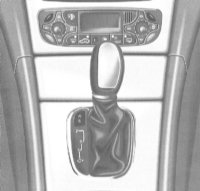 |
|
The individual gears are engaged automatically depending on :
· the position of the AT selector lever with shift ranges 4, 3, 2 and 1
· the selected shift program (W/S)
· the position of the accelerator pedal
· the driving speed.
The shift mechanism automatically adapts to the driver's individual driving style by shifting the shift points.
Shift point shifting is a continuous process, constantly taking into account the momentary operating and driving conditions, as well as the desires of the driver.
The automatic transmission responds to changing operating conditions with an adapted gearshift program.
Switching the selector lever AT is possible in position 2 of the ignition lock. To move the AT selector lever from the “P” position, additionally apply the service brake.
Starting off
Press the service brake to release the AT selector lever. Release the parking brake.
Switch the AT selector lever when the engine is idling to one of the driving positions. Wait until the gear is fully engaged, especially when the engine is cold. This is confirmed by a slight jerk.
Release the service brake and depress the accelerator pedal.
Upshifting after a cold start
After starting a cold engine, gear shifting is performed at a higher engine speed than shifting at operating temperature.
Thus, the catalytic converter reaches its operating temperature earlier.
Accelerator Pedal Position Lightly
depressing the accelerator pedal shifts to a higher gear early.
"Kickdown" - depressing the accelerator pedal beyond a point of resistance causes maximum acceleration and downshifting to the lowest possible gear.
When the desired speed is reached, release the accelerator pedal - again there is a shift to a higher gear.
Stopping the car
Leave the selector lever in the driving position "D" or "R" and use the service or parking brake to insure the car from moving forward, and on the rise - from rolling back.
Maneuvering
When maneuvering in confined spaces, adjust the speed by releasing the service brake in a controlled manner. Depress the accelerator pedal only slightly, do not play with it.
Parking
Depress the parking brake pedal.
Move the AT selector lever to the "P" position.
On steep ascents or descents, turn the front wheels towards the sidewalk curb, being careful not to damage the tires.
AT selector
lever positions The position of the automatic transmission selector lever is indicated on the dashboard display.
P Parking lock
Additional protection for the car when parking. Turn on only after the car has come to a complete stop.
|
The key can only be removed in the "P" position of the AT selector lever. |
With the key removed, the AT selector lever is locked in the “P” position.
R Engage reverse gear
only when the vehicle has come to a complete stop.
N Neutral position
There is no transmission of torque from the engine to the drive wheels. With the brakes released, the car can move freely (pushing, towing).
Do not shift to the "N" position while driving, otherwise the transmission may be damaged.
If the EPS function is deactivated or defective:
Only when the vehicle is in danger of skidding is it permitted to shift to position "N" (eg in winter on slippery roads).
D All 5 forward gears are used. The mode is provided for all normal conditions of forward movement.
Switching ranges for special operating conditions
In position "D" of the selector lever AT, switching ranges for special operating conditions are selected by lightly pressing or pressing the selector lever to the left or right.
The switched range is displayed on the dashboard.
Slightly press the selector lever in the "-" direction.
The shift is made each time by one range in the sequence D, 4, 3, 2, 1.
Press the selector lever in the direction - and keep it pressed:
The shift range changes to the currently engaged AT gear. If driving is already in the highest possible gear of the selected shift range, the shift will only take place in the next lower shift range.
|
If the selector lever is moved in the "-" direction at too high a speed, downshifting will not take place. This prevents exceeding the permissible engine speed. |
Lightly press the selector lever in the "+" direction:
Switching is performed from the currently selected shift range to the next higher shift range.
Press the selector lever in the "+" direction and keep it pressed:
Switching is carried out from the currently selected shift range directly to position "D".
|
If the transmission is in the "D" shift range, it is possible to upshift by one step by slightly pressing the selector lever in the "+" direction. |
Shift ranges:
4 Shift only up to 4th gear.
3 Shift only up to 3rd gear.
In this position, the braking action of the engine can be used.
2 Shift only up to 2nd gear.
The mode is intended for driving on steep passes, in the mountains, in difficult operating conditions, and also as a brake position on especially steep descents.
1 1st gear.
Braking position for driving on particularly steep descents and long passes.
Program switch
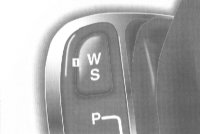 |
|
Pressing the W/S switch -1- switches between the W and S programs.
Press the "W/S" switch only when the selector lever is in "P", "N" or "D" positions.
The selected program is displayed on the dashboard.
"S" Standard mode
The mode is provided for all normal driving conditions.
"W" Winter mode
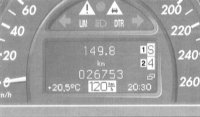 |
|
1 - Selected program
2 - AT selector lever engaged position or shift range Upshifting and downshifting
is carried out by strongly depressing the accelerator pedal at lower speeds and lower engine speeds than in the "S" program.
In the "kick-down" position of the accelerator pedal, upshifting and downshifting is carried out as in the "S" program.
Emergency mode
If the transmission can no longer be shifted while driving and retains the selected gear even under changed operating conditions, the transmission is in emergency mode.
To enable further movement, 2nd gear or 2nd reverse gear can be engaged. The sequence of actions is as follows:
Stop the car.
Move the AT selector lever to the "P" position.
Turn the ignition key to position 0.
Wait at least 10 seconds.
Start the engine.
Move the AT selector lever to position "D":
2nd gear is engaged.
Move the AT selector lever to the “R” position:
Immediately contact a Mercedes-Benz service station to check the transmission.
Parking brake
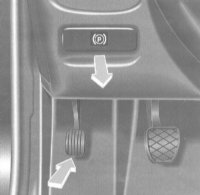 |
|
Applying the parking brake: Depress the parking brake pedal firmly. The parking brake is applied.
On the dashboard, when the parking brake is applied, the brake system warning lamp lights up.
Release: Pull the handle towards you. The parking brake is released instantly - the car can immediately move off.
The brake warning light on the dashboard goes out when the engine is running.
|
When starting off with the parking brake applied, a warning horn sounds - release the parking brake. |
Recommendations for driving a car Control
pedals
Never limit the freedom of control of the pedals. There must be no objects in the driver's footwell. When using foot mats or carpets, ensure that there is sufficient space and that they are securely fastened.
Driving and parking
When driving or when parking, make sure that parts of the exhaust system do not come into contact with flammable material.
Warming up the engine to operating temperature
After starting off, quickly warm up the engine to operating temperature. Only then can the load be brought to full power.
Starting off
Starting off on slippery ground: Be sure to avoid prolonged spinning of one of the drive wheels. This could damage the transmission.
Steering
When the engine is not running, the power steering does not work. In this case, much more effort is required to control.
Brakes The
service brake hydraulic booster works only when the engine is running. It should be noted that when the engine is not running, much more effort is required for braking.
On long and steep descents, it is recommended to unload the brakes by shifting the transmission to a lower gear - select shift ranges 3, 2 or 1.
This prevents overheating of the brakes and reduces wear on the brake pads.
After an increased load on the brakes, it is recommended that you do not immediately park the car, but first continue driving for some time in order to cool the brakes faster with oncoming air flow.
If you drive without braking for a long time in heavy rain, it may happen that there will be some delay during the first braking and you will have to apply the brake with more force. Therefore, keep a greater than usual distance from vehicles moving in front of you.
To prevent corrosion on the brake discs, before parking the vehicle after driving on a wet road, especially if it has been sprinkled with de-icing agent, press the brake firmly to dry the brake discs by heating.
service brake
With relatively low operating loads on the brake system, from time to time it is necessary to verify its effectiveness by short, strong braking at a higher speed. Thus, the brake pads are worn in.
Ensure that braking does not endanger other road users!
Observe the operating principle of the Brake Assist (BAS) emergency brake booster (see below).
If the brake warning light comes on when the parking brake is released.
Shutdown of fuel supply in forced idling
mode In the forced idling mode, fuel supply is interrupted if the accelerator pedal is fully released.
Engine malfunctions
If the engine runs erratically (for example, in the event of a misfire), unburned fuel can enter the catalytic converter and cause thermal damage to it.
In the event of misfiring, only short-term operation of the engine at a small load (at low speeds) is allowed.
The fault should be repaired immediately at a Mercedes-Benz workshop.
Hydroplaning
Depending on the water level on the road, despite sufficient tire tread depth and low speed, hydroplaning can occur. When it rains, brake carefully and avoid driving in a rut.
Tire grip
While on a dry road the vehicle is fully steerable at a certain speed, when driving on a wet or icy road, the speed must be reduced accordingly in order to achieve the same degree of driving safety.
Already at temperatures close to the freezing point, you should especially carefully monitor the condition of the road surface.
If ice has formed on the road (for example, due to fog), when braking, a thin film of water quickly forms on the ice, which significantly reduces the grip coefficient of the tires on the road. Take extra care in this weather.
In winter, it is recommended to use M + S tires (with a tread for driving on muddy and snowy roads). In icy conditions and on slippery snow, they can reduce the stopping distance compared to tires with a summer tread pattern.
Tires
Be sure to adhere to the prescribed tire pressures.
This is especially important for tires operating under extreme conditions such as high speed, full load and high outside temperatures.
Avoid severe tire wear. With a tread height of less than 3 mm, the wet grip coefficient of tires is sharply reduced.
The grip coefficient of tires with the road varies significantly depending on the weather or the condition of the road surface.
Trips abroad
The network of service stations "Mercedes-Benz" is also available abroad. The relevant lists of Mercedes-Benz workshops can be requested from any Mercedes-Benz workshop.
In some countries, only low-octane fuel is sold.
In countries with a driving order that differs from the driving order in the country where the vehicle is approved, the headlights must be switched to symmetrical dipped beam or partially sealed.
This reduces the glare of oncoming vehicles.
Winter
operation Prepare the vehicle for winter operation before winter sets in.
Change the engine oil: if the oil is not approved for winter use.
Check the concentration of antifreeze with anti-corrosion additives.
Windshield washer and headlamp cleaner
Add detergent concentrate to water.
Battery monitoring
When the temperature drops, the capacity of the battery decreases. Only a well-charged battery ensures reliable engine starting even at low temperatures.
Tires
In winter, we recommend using M + S tires on all wheels (with a tread for driving on muddy and snowy roads). At the same time, it is necessary to observe the maximum speed for tires M + S, as well as the maximum speed limited by traffic rules!
|
When driving in winter, the maximum effect of the electronic anti-skid system (ESP) is only achieved when using M + S tires and, if necessary, snow chains. |
When starting off with snow chains, disabling the function of the ESP anti-skid system can play a positive role (see later in this Section).
Tips for driving in icy conditions
The most important rule when driving in icy conditions:
Drive carefully, avoid sudden acceleration, braking and maneuvering while driving.
If the vehicle is in danger of skidding, or if the vehicle cannot be stopped at low speed, disengage the clutch or shift the automatic transmission selector lever to the “N” position.
Use the steering wheel to try to keep the car under control.
Defrost agents used on roads can have a negative effect on braking performance. Therefore, more force may be required to achieve the habitual braking action.
In this regard, it is recommended to repeatedly press the brake pedal when driving for a long time on roads strewn with defrosting agents. In this way, the inhibitory effect reduced by the defrosting agents can be normalized again.
Make sure that braking does not endanger other road users!
If, after driving on roads sprinkled with defrosting agents, the vehicle is parked, the braking effect should be checked as soon as possible, with due care, before continuing the journey. If there is a noticeable decrease in braking efficiency, it can be restored by repeatedly depressing the brake pedal.
Snow chains
Use only snow chains tested and approved by MB.
Snow chains are only permitted on certain wheel and tire combinations. (More detailed instructions are given in the Specifications).
Apply snow chains only to the rear wheels (drive axle). Follow the manufacturer's installation instructions.
The maximum driving speed (50 km/h) is only allowed when driving on snow.
On snow-free roads, the snow chains should be removed as soon as possible.
(Recommendations for driving in icy conditions are given above).
When snow chains are used, the ESP anti-skid function can be disabled (see below).
Trailer towing
|
Do not exceed the maximum drawbar load, the permissible tow load and the permissible rear axle load of the vehicle. |
The installation instructions for the tow hitch with detachable ball head must be strictly observed.
When operating with a trailer, it must be taken into account that the dynamic properties in this case differ markedly from the dynamic properties of a vehicle without a trailer.
A train with a trailer is heavier, has limited acceleration and climbing ability, and a longer stopping distance. It reacts more sensitively to crosswind gusts, etc. and requires more careful driving.
Fuel consumption when driving a car with a trailer naturally increases.
When loading a trailer, make sure that the gross trailer weight and the permissible weight of the load towed by the vehicle together with the towing device (Specifications) are not exceeded.
Permissible values are indicated in the vehicle passports and on the nameplates of the tow hitch and trailer.
The lowest value is valid.
In addition, the permissible load of the trailer drawbar on the ball head of the tow hitch must not be exceeded.
The maximum bearing load is indicated in the Specifications or on the adhesive plate. It must not exceed the value indicated on the nameplates of the tow hitch and the trailer.
We recommend using the maximum drawbar load on the trailer, and not less than 50 kg.
According to the drawbar load, the load weight in the vehicle must be reduced in order to avoid exceeding the permissible load on the rear axle.
It is recommended not to exceed the maximum speed of 80 km/h, incl. and in countries that allow higher speeds.
Harsh braking should be avoided as much as possible and should be applied lightly at first in order to roll the trailer onto the tractor. Then gradually increase the braking force.
If the trailer begins to wobble, slow down, do not turn the steering wheel against the skid and, if necessary, brake. In no case do not try to "stretch" the composition by increasing the speed of movement.
The values given in the Specifications for starting off hill climbing ability refer to sea level. When driving in the mountains, it must be remembered that as the altitude increases, the engine power and, consequently, the ability to overcome the rise when starting off, decrease.
|
Trailers with an overrun braking system must not be uncoupled while coasting. Damage to the bumper may occur due to the reverse motion of the inertial braking system. |
Tempostat
Tempostat automatically maintains the set speed.
The cruise control switch on the steering column can be used to select and activate the cruise control or variable speed limiter.
The selected system, tempostat or adjustable speed limiter is indicated by the LIM indicator on the tempostat switch lever:
· Tempostat:
the LIM indicator on the tempostat switch lever is off.
· Adjustable speed limiter: LIM indicator on the tempostat switch lever is lit - refer to subsection “Adjustable speed limiter”.
 |
|
1 Recording the speed of movement - lightly press the lever of the cruise control switch.
Acceleration - keep the tempostat switch lever pressed.
Accurate setting in steps of 1 km/h - briefly press the tempostat switch lever.
2 Recording the speed of movement - lightly press the lever of the cruise control switch.
Decreasing speed - keep the switch lever pressed.
Fine-tuning in steps of 1 km/h - briefly press the switch lever.
3 Shutdown - lightly press the switch lever.
The speed limit remains in memory.
4 Recall the memorized speed - lightly press the cruise control switch lever.
5 Switching between variable speed limiter and cruise control - press the switch lever.
The tempostat is selected if the LIM indicator on the tempostat switch lever is off.
The adjustable speed limiter is selected if the LIM indicator on the cruise control switch lever is on.
|
The tempostat function does not automatically adapt to the road conditions, so the tempostat cannot be used, for example, in icy conditions. |
It is possible to write to the memory of any speed above 32 km/h on petrol models and 40 km/h on diesel models.
Switching from an adjustable speed limiter to a tempostat. The LIM indicator on the tempostat switch lever must be off. If necessary, press the tempostat switch lever in direction -5-.
Pick up the desired speed by depressing the accelerator pedal.
Lightly press the tempostat switch lever in direction -1- or -2-. The speed is memorized.
The memorized speed is displayed on the information display, and the segments from the memorized speed to the maximum speed light up on the speedometer.
Release the accelerator pedal.
|
When the speed of the vehicle is increased by pressing the tempostat switch lever in the direction -1- or the speed is reduced in the direction -2- after releasing the tempostat switch lever, the speed is stored in the memory. |
Precise setting in steps of 1 km/h
Increasing speed - Press the cruise control switch lightly in direction -1-.
Speed reduction — the lever of the tempostat switch slightly press in the direction -2-.
Recalling the entered speed from the memory
Slightly press the switch lever in the direction -4-.
Select the memorized speed only if the driver remembers it well and intends to recall it again.
|
Turning the ignition key to position 1 or 0 resets the memorized speed. |
Switching off:
Briefly press the tempostat switch lever in the direction -3- or -5-, the speed remains in the memory.
When pressed in direction -5-, the LIM indicator on the tempostat switch lever lights up - an adjustable speed limiter is selected.
The tempostat also turns off when the brake pedal is pressed, the clutch pedal is pressed for more than 4 seconds, or the AT selector lever is moved to the “N” position while driving.
|
Remarks: On ascents or descents, a deviation from the set speed is possible. On models with AT, the tempostat reduces the deviation from the speed selected by the driver by shifting the gearbox to a lower gear. Despite this, it is possible that the set speed cannot be maintained. |
After overcoming such a section, the memorized speed is automatically set and the transmission returns to its previous position.
If the speed of the car is reduced by pressing the lever of the cruise control switch in the direction -2-, then if the speed is not sufficiently reduced, the transmission is switched to 4th or 3rd gear.
For a short-term increase in speed (for example, to overtake) - press the accelerator pedal. If the accelerator pedal is released again, the memorized speed is set again.
Use the cruise control only if the road conditions permit a steady speed.
Notes for models with manual transmission and with automatic transmission Sequentronic in manual mode
After changing gear, lightly depress the accelerator pedal. This improves the smoothness of switching.
After releasing the accelerator pedal, the set speed is restored.
If the shift gate is in neutral after depressing the clutch pedal, a short increase in engine speed is possible.
Always drive with sufficient, but not exceeded engine speed - change gears in a timely manner. When shifting gears, the tempostat does not turn off. Avoid downshifting through multiple gears. If, when shifting gears, the clutch pedal was depressed for more than 4 seconds, the tempostat turns off.
Notes for models with Sequentronic automatic transmission in automatic mode or with AT:
If the vehicle speed is reduced by pressing the tempostat switch lever in the -2- direction, then if the speed is not sufficiently reduced, the gearbox is switched to 4th or 3rd gear.
Speedtronic
Adjustable speed limiter
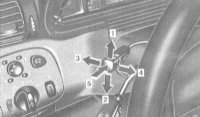 |
|
1 Activate the variable speed limiter - lightly press the cruise control switch lever.
Increasing the speed limit - keep the tempostat switch lever pressed.
2 Activate the variable speed limiter - lightly press the cruise control switch lever.
Reducing the speed limit - keep the tempostat switch lever pressed.
3 Deactivate the variable speed limiter - lightly press the cruise control switch lever.
The set speed limit remains in memory.
4 Memory speed limit recall - lightly press the cruise control switch lever.
Accurate control, increasing the speed limit in steps of 1 km / h - briefly press the lever of the cruise control switch.
5 Switch between cruise control and variable speed limiter - press the cruise switch lever.
The adjustable speed limiter is selected if the LIM indicator on the cruise control switch lever is on.
The tempostat is selected if the LIM indicator on the tempostat switch lever is off. (Tempostat discussed earlier in this Section).
Switching/Activation
Start the engine.
With the engine running, any speed limit above 30 km/h is possible.
Switching from tempostat to adjustable speed limiter.
The LIM indicator on the tempostat switch lever should be on. If necessary, press the tempostat switch lever in direction -5-.
Lightly press the switch lever in direction (1, 2 or 4).
The adjustable speed limiter is activated.
The set speed limit is displayed on the information display, and the LIM indication lights up on the speedometer.
Direction -1-
Travel speed is stored as the new speed limit; this rounds up to the next higher ten. Further light pressing or holding the lever increases the set speed limit.
Direction -2-
Travel speed is stored as the new speed limit; this rounds off to the next lower ten. Further light pressing or holding the lever lowers the set speed limit.
Direction -4-
The last memorized speed limit is activated if the driving speed exceeds the limit by no more than 30 km/h.
By further lightly pressing or holding the lever, the set speed limit is increased in steps of 1 km / h.
Deactivation
Slightly press the switch lever in direction -3- or push in direction -5-.
All segments light up on the speedometer.
When pressed in direction -5-, the LIM indicator on the tempostat switch lever goes out.
The speed limiter is also deactivated if, in the kick-down position of the accelerator pedal, the speed differs from the preset speed by no more than 20 km/h.
|
Depending on the design, slight deviations of the speedometer readings from those set by the speed limiter are possible. |
The unit of measure for the forward speed display can be selected in the "INSTRUMENT CLUSTER" menu of the "Custom setting" system, in the setup menu "DISPLAY VALUES IN"
If in the "INSTRUMENT CLUSTER" menu and "VEHICLE" (VEHICLE) of the "Custom setting" system, the setting menus "DISPLAY VALUES IN" (VALUES ON DISPLAY B) and "SPEED LIMIT" (WINTER TIRES) are called up, then the adjustable speed limiter cannot be activated.
If the speed limiter cannot maintain the set speed (for example, on downhill gradients), an audible signal will sound and "LIMIT EXCEEDED" will appear on the universal display. In addition, the LIM indicator flashes on the speedometer.
In the event of a malfunction of the adjustable speed limiter, refer to the "Speedtronic" subsection.
Permanent speed limiter (Germany only)
The permanent speed limiter can be set in the "VEHICLE" menu of the "Individual setting" system to certain values (e.g. when operating a vehicle with winter tires) in the "SPEED LIMIT" setup menu ( WINTER TIRES), (SPEED LIMIT - WINTER TIRES).
Shortly before reaching the set speed limit, its value is indicated on the universal display. Additionally, the LIM indicator on the speedometer lights up.
The set constant speed limit cannot be exceeded by depressing the accelerator pedal beyond the point of resistance. For models with automatic transmission, this corresponds to the position of the accelerator pedal "kick-down".
|
Remarks: Depending on the design, slight deviations of the speedometer readings from those set by the speed limiter are possible. |
Emergency Brake Assist (BAS) (Brake Assist)
Brake Assist helps you shorten your stopping distance when braking in dangerous driving situations. It allows you to take full advantage of the anti-lock brake system (ABS).
When the brake pedal is pressed hard, it provides maximum build-up of braking force. To achieve the shortest possible braking distance, do not reduce the force of your foot, but continue to press the brake pedal.
When the brake pedal is released, the booster turns off; service brakes are used.
|
In the event of a malfunction of the emergency brake booster - see "Warning system and fault signaling" . |
Anti-Lock Brake System (ABS)
When the ignition switch is in position 2, the ABS warning light comes on. It goes off when the engine is running.
If the ABS warning light on the dashboard stays on while the engine is running.
The ABS system prevents the wheels from locking, regardless of road conditions, from a speed of about 8 km/h.
If the speed of one of the wheels during braking deviates from the speed of the others, ABS begins to control the brake pressure, while the car vibrates and a slight pulsation of the brake pedal is felt. Thus, the driver is notified about the operation of the ABS.
If further braking is necessary, do not reduce foot pressure on the pedal. In this way, the advantage of the ABS system is used - braking while maintaining controllability of the car.
If full braking is required, depress the brake pedal with full force, thereby providing control mode using the ABS system.
On slippery roads, with ice and snow, the system can be activated already at low braking force. The resulting pulsation of the brake pedal indicates that the driving style should be changed according to difficult road conditions.
 |
|
Electronic Anti-Skid (ESP)
The electronic ESP system improves the vehicle's driving stability and traction capability in all operating modes.
If the key in the ignition switch is in position 2, the warning light on the speedometer lights up. It goes off when the engine is running.
By braking the wheels and limiting the engine torque, skidding or insufficient vehicle control is counteracted. At the same time, the warning signal lamp on the speedometer flashes.
If the ignition key is in position 2, the warning light on the speedometer will illuminate. It goes off when the engine is running.
Disabling, enabling the function of the anti-skid system ESP
The switch is located on the center console.
Press the switch:
1 Off
2 On
Off
Press the ESP switch at the top (1).
The warning light on the speedometer comes on.
When operating a vehicle with snow chains, in deep snow, sand or gravel, turning off the anti-skid function when starting off or while driving can play a positive role. In this case, the engine torque is not limited and the drive wheels can spin, creating a milling action.
The traction control function is also activated when one drive wheel reaches the limit of tire adhesion to the road, for example, when one-sided icy conditions. To prevent this wheel from spinning, it is braked until sufficient traction is achieved. This traction control function is activated at speeds up to approximately 40 km/h. It switches off at the latest at a speed of about 80 km/h.
The warning light on the speedometer will flash at any speed if the tires have reached their traction limit.
Turning on
To return to normal driving, press the ESP switch (2). The warning light on the speedometer goes out and the anti-skid function is again operational.
|
When towing with the front axle raised or checking the parking brake on the brake test stand, the engine must be off. Otherwise, due to the active braking action via the ESP system, the rear axle brake system may be damaged. |
|
When driving the vehicle in winter, the maximum effect of the electronic anti-skid system (ESP) is achieved only when using tires with a winter tread pattern (M + S) and, if necessary, snow chains. |
If wheels with different tire sizes are used, the ESP system will not function properly.
If the anti-lock brake system (ABS) is faulty, the electronic anti-skid system (ESP) and the emergency brake assist (BAS) are also turned off.
In the event of a malfunction of the electronic anti-skid system - see "Warning system and fault signaling".
Parktronic System (PTS)
The Parktronic system visually and acoustically warns you of a dangerous distance between your vehicle and an obstacle.
If the ignition key is turned to position 2, the Parktronic system is automatically switched on and remains active up to a speed of approximately 15 km/h.
At higher speeds, the Parktronic system is automatically deactivated. At low speed, it automatically turns on again.
Activation of signaling devices with the corresponding control zone is carried out depending on the position of the automatic transmission selector lever.
The position of the selector lever AT
"D" signaling devices of the front zone are activated.
"R", "N" signaling devices of the front and rear zones are activated.
"P" signaling devices are deactivated.
Sequentronic automatic transmission lever positions:
"G", "A", "N" front warning lights activated.
"R" front and rear warning lights activated.
Position of the backstage of the manual transmission:
Except for reverse gear: signaling devices for the front zone are activated;
Reverse: Alarms for the front and rear zones are activated.
The Parktronic system can be turned off using the switch in the center console.
signaling devices
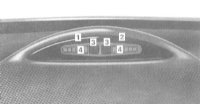 |
|
Signaling devices for the front zone are shown.
1 Left side of the vehicle
2 Right side of the vehicle
3 Frames
4 Segments The
front warning lights are located on the instrument panel above the middle air vent.
The rear zone warning devices are located on the headlining at the rear of the passenger compartment.
If the Parktronic system is switched on, the frames (3) light up on the signaling devices.
The distance between the sensor and the obstacle is indicated by segments (4) of signaling devices.
The signaling devices are divided into 6 yellow and 2 red segments.
If the vehicle approaches an obstacle detected by the sensors, one or more segments light up depending on the distance.
Starting from the seventh segment, an intermittent warning sound is additionally heard, and from the eighth segment - a continuous warning sound signal for a maximum of 3 seconds.
Sensors
 |
|
The immediate area is monitored by 6 sensors -1- on the front bumper and 4 sensors on the rear bumper.
Range of sensors
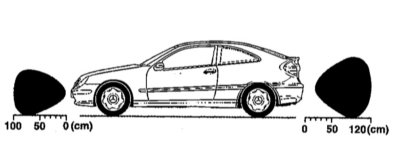 |
|
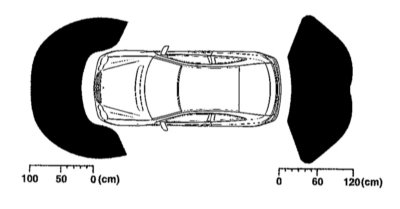 |
Front bumper: in the middle about 100 dark about 60cm
Rear bumper: in the middle about 120 dark about 80cm
At these distances, the first yellow segment lights up. As the distance decreases, other segments light up.
Minimum distance between sensor and obstacle:
front corners approx. 15 cm
in the middle approx. 20 cm
All yellow segments and one or both red segments light up. In addition, a warning tone sounds for approximately 3 seconds.
Further approach may cause the obstacle to no longer be displayed (the segments do not light up).
When parking, pay special attention to objects below or above the sensors, such as pedestals or trailer drawbars.
Such objects in the immediate vicinity (about 30 cm) may not always be recognized by the system and thus may be damaged or cause damage to the vehicle.
The function of the Parktronic system may be impaired if the sensors are damaged or covered with mud, snow, ice and especially snow.
Interference from other sources of ultrasound, such as the air brakes of trucks or pneumatic hammers, cannot be completely excluded either.
It is possible that certain objects that may touch the front or rear of the vehicle will not be recognized by the system's sensors.
Switching off the Parktronic system
 |
|
The switch is located on the center console.
Press the switch:
1 Off
2 On
3 Control LED - Lights up when the Parktronic system is off
Switches on automatically when the ignition key is turned to position 2.
Towing
a trailer not activated.
If the power cable is disconnected, the rear protection function is activated again.
|
The trailer adapter with 7-pin plug must be unplugged after unplugging the trailer, otherwise the rear protection function remains inactive. |
Malfunction of the Parktronic system
In the event of a malfunction, only the red segments of all signaling devices light up.
The cause may be an extraneous ultrasound source or a dirty transducer.
After cleaning the sensors, turn the ignition key back to position 2.
In the event of a malfunction, a warning horn sounds for approximately 3 seconds and the indicator LED on the Parktronic switch in the center console comes on. The system is shutting down!
Immediately address on HUNDRED "Mercedes-Benz" for check of the "Parktronic" system.
Remote garage door opener
Risk of accident!
Pressing one of the buttons on the transmitter of the built-in remote control in the interior rearview mirror is only allowed if there are no people or objects in the movement range of the garage door opener; Otherwise, there is a risk of injury to persons due to the opening door.
The remote control integrated in the interior rearview mirror can open or close up to three different door systems.
|
Some garage door openers cannot be controlled by the built-in remote control. You can get more detailed information at the Mercedes-Benz service station. |
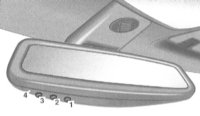 |
|
1 Transmitter
button 2 Transmitter button
3 Transmitter button
4 Control LED
Programming the built-in remote control The
transmitter buttons -1-, -2- and -3- can be programmed.
Programming using the transmitter button -1- as an example:
· Turn the ignition key to position 1 or 2.
· Press and hold the transmitter button -1- until the control LED -4- flashes approximately once per second .
· Keep the transmitter button -1- pressed.
|
Note: The control LED -4- starts flashing immediately if one of the transmitter buttons is being programmed for the first time or if the contents of the built-in remote control memory have been previously reset. |
· When reprogramming a programmed transmitter button, the control LED -4- starts flashing after approx. 20 seconds.
· Keep the portable garage door opener remote control pointed (transmitter output) to the left side of the interior rearview mirror. Press the transmitter button of the portable remote control until the control LED -4- flashes quickly.
· Programming was successful.
· Release the transmitter button -1-.
|
If the garage door opener operates with Rolling-Code, the vehicle transmitter and the garage door opener transmitter must be synchronized. |
Opening/Closing the Garage Door The
built-in remote control, after being programmed, assumes the properties of the portable remote control for the garage door opener system (refer to the relevant "Operator's Manual").
· Turn the ignition key to position 1 or 2.
· Press the desired transmitter button (1, 2 or 3) according to the programming.
· The garage door opens or closes.
|
The transmitter works as long as the transmitter button is pressed. After a maximum of 20 seconds, the transmission process is interrupted and the control LED -4- starts flashing. If necessary, press the transmitter button again. |
Resetting the built-in remote control memory
Turn the ignition key to position 1 or 2.
Press the buttons -1- and -3- for approx. 20 seconds until the control LED -4- flashes in accelerated pace.
· The contents of the memory have been reset.
|
Before selling the vehicle, we recommend that you reset the internal remote control memory. |
Refueling
Locking and unlocking the fuel filler flap is performed together with locking and unlocking the doors and trunk lid using the remote control.
Information about fuel grades is given in the Specifications.
Remove the key from the ignition switch.
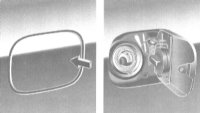 |
|
Open the fuel filler cap: press in the direction of the arrow and open.
Open the fuel tank cap:
turn to the left and hold to relieve excess pressure.
Remove the fuel tank cap and insert it into the holder located on the inside of the fuel tank manhole cover.
Fill the fuel tank only to the level at which the dispenser gun turns off - do not overfill the tank.
Close the fuel tank cap: turn to the right until it locks.
Close the fuel tank cap.
Source: http://www.auto-knigi.com/model/mb_c/2_16/
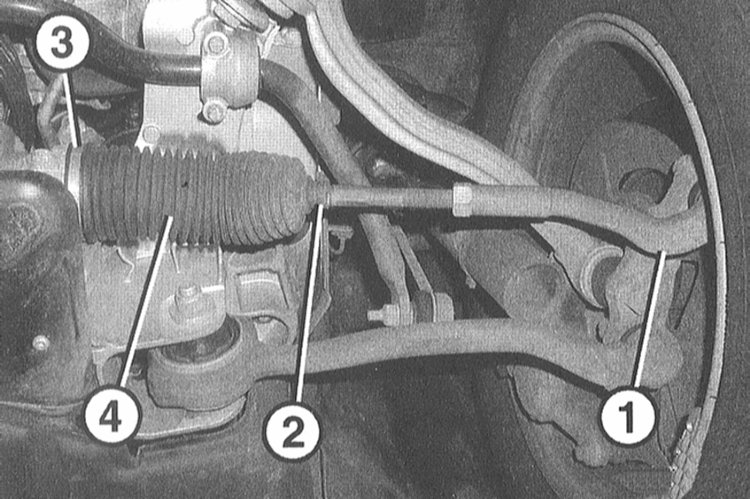
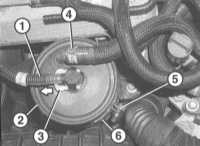
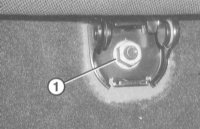
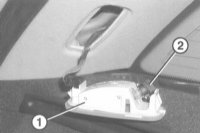
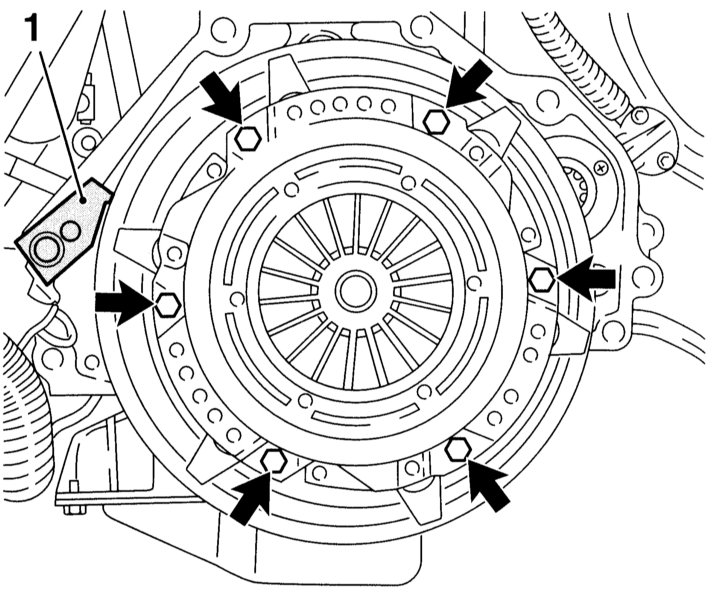
![W203/S203/CL203 [2000 - 2004]](/uploads/mercedes-c-klass-w203.jpg)
